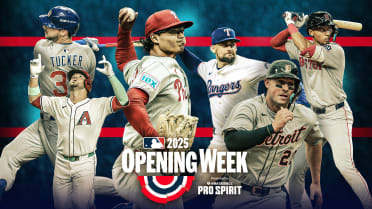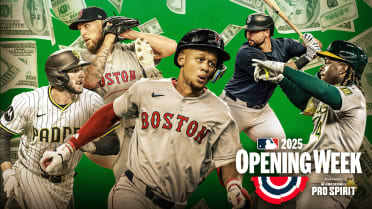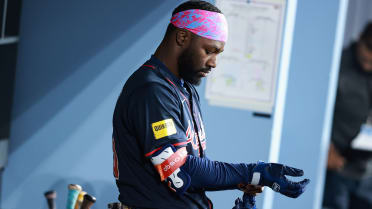Nearly three months ago, we ran a piece titled "2018's Most Improved Hitters." It wasn't just based on early-season stat lines; it was looking at under-the-hood factors like improved hard-hit rate or decreased strikeouts. Most of the names made plenty of sense, like Mookie Betts, Xander Bogaerts and Mitch Haniger. Sometimes it's not hard to see improvement.
One name that didn't make sense on that Top 10 was Amed Rosario. At the time, he was hitting .251/.284/.366, a line that was 25 percent worse than the Major League average. If the underlying peripherals were trying to tell us a breakout was coming for Rosario, it was a difficult one to see. And all these months later, he's hitting all of .249/.290/.372, which is to say ... nearly the same below-average line he had back in June.
Rosario's breakout hasn't officially arrived yet, but the factors that made him pop up on our list back in June haven't changed -- and we might just be finally seeing the beginnings of the production that the improved underlying metrics hinted at.
Over the past three weeks dating back to the Mets' off-day on Aug. 9, Rosario is hitting .329/.360/.482. He just put up seven hits in three games in Wrigley Field against the Cubs. Now we're only talking about 90 plate appearances here, and in most cases, you'd be tempted to pass this off as a hot streak. Maybe that's all it is. But with Rosario's very recent status as a highly rated prospect, and with the arrows all still pointing in the right direction, now seems like the right time to dig into this a little more.
Are we seeing the start of Rosario's ascension? If we are, these are the reasons why.
Rosario is striking out less and walking more
In his partial-season debut in 2017, Rosario struck out 29 percent of the time -- that's bad; the Major League non-pitcher average was 21 percent. He walked just three times, which came out to a walk rate of 1.8 percent -- that's bad, too; it was the lowest in the Majors. In fact, Rosario struck out 16 times for every walk, which was one of the dozen worst ratios of any player with 150 plate appearances in a season dating back to the dawn of integrated baseball back in 1947.
So there's that, but there's also this: Rosario has shown improvement on both of those numbers this year. (You might rightfully point out that he didn't have a high bar to clear, and that's true. But he's only 22, and a poor debut doesn't mean that movements in the right direction don't count.) Rosario's walk rate has nearly tripled from that 1.8 percent to 5.1 percent, which is still below average, but better.
More impressively, Rosario has stopped striking out so much. There have been 450 hitters who have taken at least 150 plate appearances in each of the past two years, and only four have cut their strikeout rate by as much as Rosario has.
Biggest improvements in strikeout rate in 2017-18
- 12.4 percent, JaCoby Jones (42.2 to 29.8)
- 9.8 percent, Corey Dickerson (24.2 to 14.4)
- 8.8 percent, Trevor Story (34.4 to 25.6)
- 8.6 percent, Adam Engel (34.8 to 26.2)
5. 8.3 percent, Rosario (28.8 to 20.6)
That's not just a big step forward, that's eliminating a weakness. The non-pitcher strikeout average this year is 21.5 percent, and Rosario is below that. He's also now slightly better than average at making contact. That doesn't happen by accident, of course. Rosario has made some notable changes.
"The hitting coaches really feel like he's making some improvements from day to day, week to week," Mets manager Mickey Callaway told MLB.com back in July, a positive sign given that the team had benched Rosario for a few days in late June to find those improvements.
You can find those changes in the numbers. Rosario has been swinging at more strikes as the year has gone on. He's been missing fewer and fewer of those in-the-zone pitches as the year has gone on. As far as plate discipline goes, that's the trend you want to see.
All told, Rosario's chase rate -- swings outside the zone, also known as "exactly what a pitcher wants you to do" -- is down from 40 percent to 35 percent. His contact rate in the zone is up from 70 percent to 80 percent. Rosario is walking more, he's whiffing less and he's making better plate decisions. That's not all, either.
Rosario is hitting the ball harder
Let's be clear here: Rosario is always going to be more Billy Hamilton than Giancarlo Stanton. He's not in the Majors to crush homers, and no one expects that he's going to be a 30-homer type. Rosario has 28 total homers in parts of six professional seasons.
Still, it's good to hit the ball hard. We define a "hard-hit" ball as one that's hit with at least 95 mph of exit velocity, because that's where hitting the ball hard really "matters." So far this year, the Majors are hitting .523 with a 1.044 slugging percentage at 95 mph or more of exit velocity, and just .220 with a .259 slugging below it. Even if you're not a power hitter, it's good to hit the ball hard.
Last year, Rosario's hard-hit rate was a mere 25 percent, below the average of 33.3 percent. This year, that's jumped up to 32 percent, which is still slightly below average. But the point here isn't to say that Rosario is a slugger. It's that he's trending in the right direction.
Rosario has also shown the ability to get to some seriously hard-hit levels, when things go right. When he hit a homer on May 20, it came off his bat at 109.5 mph. While that's just a single batted ball, it also tells you something about what Rosario can do; only 2 percent of all batted balls in the Majors this year have been hit that hard. Consider that he has a single ball hit that hard, which is exactly what you could also say about sluggers Chris Davis, Nolan Arenado, Charlie Blackmon and Matt Carpenter.
Rosario has something they don't, of course, and that's elite speed, as he ranks in the 97th percentile of the Sprint Speed leaderboards.
Again, none of this is to guarantee that Rosario is going to be a star. He's still a player with an unacceptably poor career line of .249/.285/.372 in essentially a full season of play. It's going to take more than a few good weeks to change that. But Rosario is still so young, younger than rookies Miguel Andujar, Harrison Bader and Brian Anderson. He was a consensus top prospect just a year ago, for good reason. The underlying signs of improvement have been there for most of the season for Rosario. It seems like the actual production may finally be arriving behind it.
Mike Petriello is an analyst for MLB.com and the host of the Statcast podcast.



